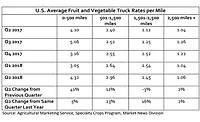Manufacturing News
Out for comment: FSMA on food defense
The Proposed Rule on Focused Mitigation Strategies to Protect Food Against Intentional Adulteration is out for comment until the end of March.
While FSMA sections on the Produce Safety Rule and Hazard Analysis and Risk-Based Preventive Controls for Human Food Rule have garnered the lion’s share of the news in the last few months, the Proposed Rule on Focused Mitigation Strategies to Protect Food Against Intentional Adulteration is out for comment until the end of March. Though no large-scale events have occurred, a few small ones have affected small groups of people for various, unrelated reasons.
The intentional adulteration rule actually consists of three major sections. Section 103 allows FDA to issue regulations establishing requirements for facilities that manufacture, process or hold food and requires them to consider hazards that may be intentionally introduced, including acts of terrorism. Section 106 requires FDA to issue regulations to protect food for which there is a high risk of intentional contamination that could cause serious adverse health consequences or death to humans or animals. Section 105 directs FDA to issue science-based, minimum standards for the safe production and harvesting of produce, and requires the final rule to consider hazards that may be intentionally introduced, including by acts of terrorism.
Intentional adulteration wasn’t addressed by the produce safety and process rules, which are based on HACCP and other food safety systems. Therefore, FDA realized intentional adulteration would require a different set of controls.
Intentional adulteration of the food supply, as defined by FDA, could result in catastrophic public health consequences, widespread public fear, loss of public confidence in the safety of food and the inability of the government to ensure food safety. In addition, such an event could also cause adverse economic impacts, including disruption of trade—not to mention the effect it could have on major brands or suppliers.
Acts of adulteration can take on several forms. Intentional adulteration is usually the act of disgruntled employees, consumers or competitors or an act of economically motivated adulteration (EMA) gone awry—a good example being the Chinese melamine scandal a few years ago, which affected pets in America and 290,000 infants in China.
“The goal is to protect the food supply from those who may attempt to cause large-scale public health harm,” says Michael Taylor, FDA deputy commissioner for foods and veterinary medicine. “Such events, while unlikely to occur, must be taken seriously because they have the potential to cause serious public health and economic consequences. FDA’s goal is to devise an approach that effectively protects the food supply in a practical, cost-effective manner.”
FDA proposes a targeted approach focused on the areas in a processing plant that are most vulnerable to attack. Under the proposed rule, a food facility would be required to have a written food defense plan addressing significant vulnerabilities in its production process. Facilities would have to identify and implement strategies to address these vulnerabilities, establish monitoring procedures and corrective actions, verify the system is working, ensure personnel assigned to vulnerable areas receive appropriate training and maintain applicable records.
However, the proposed rule does not apply to all facilities. For example, it doesn’t apply to facilities holding food unless it’s held in liquid storage tanks. It does not apply to the packing, repacking or relabeling of food where the container that directly contacts the food remains intact, nor does it apply to certain facilities that handle alcoholic beverages. For more information on which facilities are affected, see the “Scope of the Proposed Rule” within the Executive Summary at the web address below.
Over the years, there have been sporadic cases of intentional adulteration. While none of the incidents mentioned here occurred in a food plant, processors need to be aware of these criminal activities. In 1984, members of a group in Oregon intentionally contaminated food in restaurants with salmonella to keep the general public from voting in local elections. In this incident, 751 became ill; 45 people were hospitalized. In 1996, 12 lab workers in a medical facility in Texas became ill after eating anonymously donated pastries infected with bacteria removed from the lab’s stock culture. In 2009, two related incidents resulted in 49 people reporting the rapid and acute onset of gastrointestinal and neurological symptoms after eating meals at a Kansas restaurant. Authorities found that salsa in the restaurant had been laced with an insecticide, methomyl. Two former employees were found guilty of intentionally contaminating the salsa.
For more information on the proposed rule, visit www.fda.gov/Food/GuidanceRegulation/FSMA/ucm378628.htm
Looking for a reprint of this article?
From high-res PDFs to custom plaques, order your copy today!






